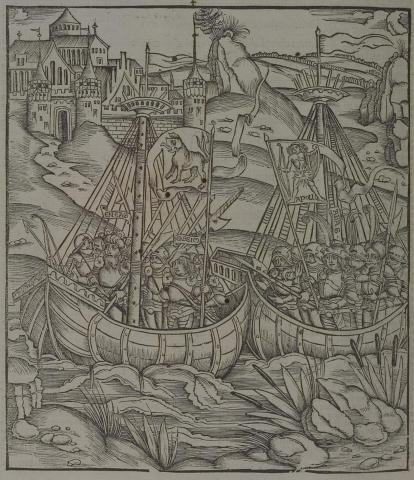Annotations
Two ships sail in front of a city that in this instance is probably Aeneas' Troy. In the ship on the left, Massicus holds a flag with an image of a tiger; in Vergil, the Tiger is actually the name of his ship (166). On the right is Abas, holding a flag with an image of Apollo, which, in Vergil's description, is the figurehead on his ship (170-1). Both Massicus and Abas are shown in their ships surrounded by some of the soldiers under their command (166-74). Aeneas is shown in Massicus's ship simply to identify the ships as his allies, though he would have sailed in his own ship. The two generals and their soldiers are a small portion of the people gathered from around the Etruscan region to support Aeneas in his war against Turnus (163-214)
Woodcut illustration from the “Strasbourg Vergil,” edited by Sebastian Brant: Publii Virgilii Maronis Opera cum quinque vulgatis commentariis expolitissimisque figuris atque imaginibus nuper per Sebastianum Brant superadditis (Strasbourg: Johannis Grieninger, 1502), fol. 352v, executed by an anonymous engraver under the direction of Brant.


Sebastian Brant (1458-1521) was a humanist scholar of many competencies. Trained in classics and law at the University of Basel, Brant later lectured in jurisprudence there and practiced law in his native city of Strasbourg. While his satirical poem Das Narrenschiff won him considerable standing as a writer, his role in the transmission of Virgil to the Renaissance was at least as important. In 1502 he and Strasbourg printer Johannes Grüninger produced a major edition of Virgil’s works, along with Donatus’ Life and the commentaries of Servius, Landino, and Calderini, with more than two hundred woodcut illustrations. (Annabel Patterson)